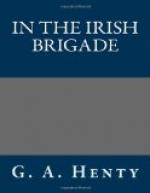The battle began at twelve o’clock, Charles’s force marching in two lines, with the exception of Stanhope’s cavalry and infantry. These, from their situation, were the first to come in contact with the enemy. The four battalions first pushed forward up the hill, and, driving the Spanish cavalry back, allowed Stanhope’s horse to ascend the hill and form on its crest. The battle speedily ranged along the whole line. The Spaniards, with superior numbers, gained ground on their left. Here O’Mahony’s corps were stationed, and they drove a portion of the allies across the Ebro again; but this success was more than counterbalanced on the other flank, where Stanhope’s cavalry and infantry carried all before them. The latter, posted in a hollow, opened so heavy a fire upon the Spanish infantry, as they advanced, that they fell into disorder; and as their cavalry were driven off, hotly pursued by Stanhope, they fell back upon the centre, which they threw into disorder. Seeing that the battle was lost, the Marquis de Bay gave the order to retire.
Two hours after the first shot was fired, the rout of the Spanish centre and right was complete, but a considerable portion of the troops were rallied by de Bay at Alagon, three leagues above Saragossa. The left wing, under Generals Amezaga and O’Mahony, were checked in their course of victory by the disaster which befell the centre and right; but, maintaining their discipline, they fell back in good order, and rejoined their defeated comrades at Alagon.
All the cannon and most of the colours of the regiments forming the centre and right fell into the hands of the victors. The loss of the allies was about two thousand men, killed or wounded; and that of the Spaniards and French three thousand killed and wounded, and between five and six thousand prisoners. Philip rode at once to Madrid, and on the evening of the battle the archduke entered Saragossa; while de Bay retired, with the broken remains of his troops, towards Navarre.
Desmond and O’Neil, who had ridden behind O’Mahony, saw the Spanish troops of the archduke yield before the impetuous attacks of the Irish regiments, who, as they pressed their foes backwards, burst into loud cheering, believing the victory already won. Presently, O’Mahony stopped the advance.
“We must not push too far forward,” he said. “It seems to me that things are not going so well in other directions. Our centre is being pressed back. What is going on on the right I cannot say, but the enemy seems to have gained the top of the hill, for our cannon there are silent. If the centre is driven back, those we have now beaten will rally, and we shall be taken in flank by the fire of their centre. Therefore, let us be content with what we have done, and wait and see how things turn out elsewhere.”
Even before the rout of the Spanish right, their centre was yielding, for opposed to them were the British and Dutch regiments, whose attack they were altogether unable to withstand. It soon became clear that, at all other points on the field, the battle was going against the Spaniards, and an aide-de-camp presently rode up, hastily, with orders from Marshal de Bay for his left to fall back and retire to Alagon.




